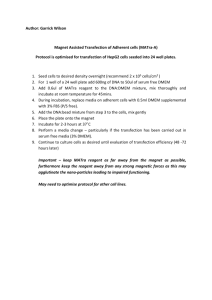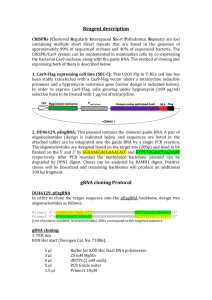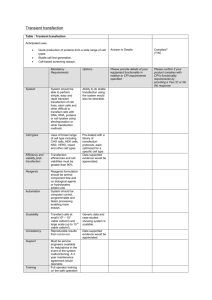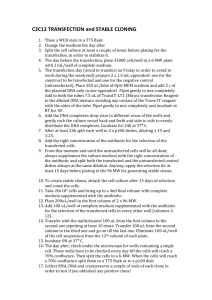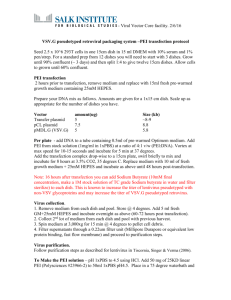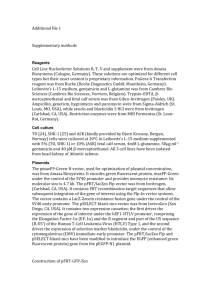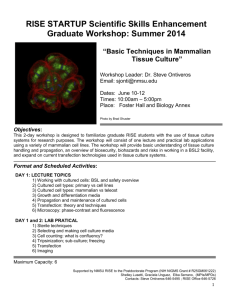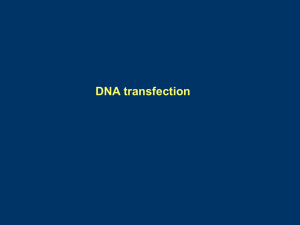Lentiviral Packaging Protocols
advertisement
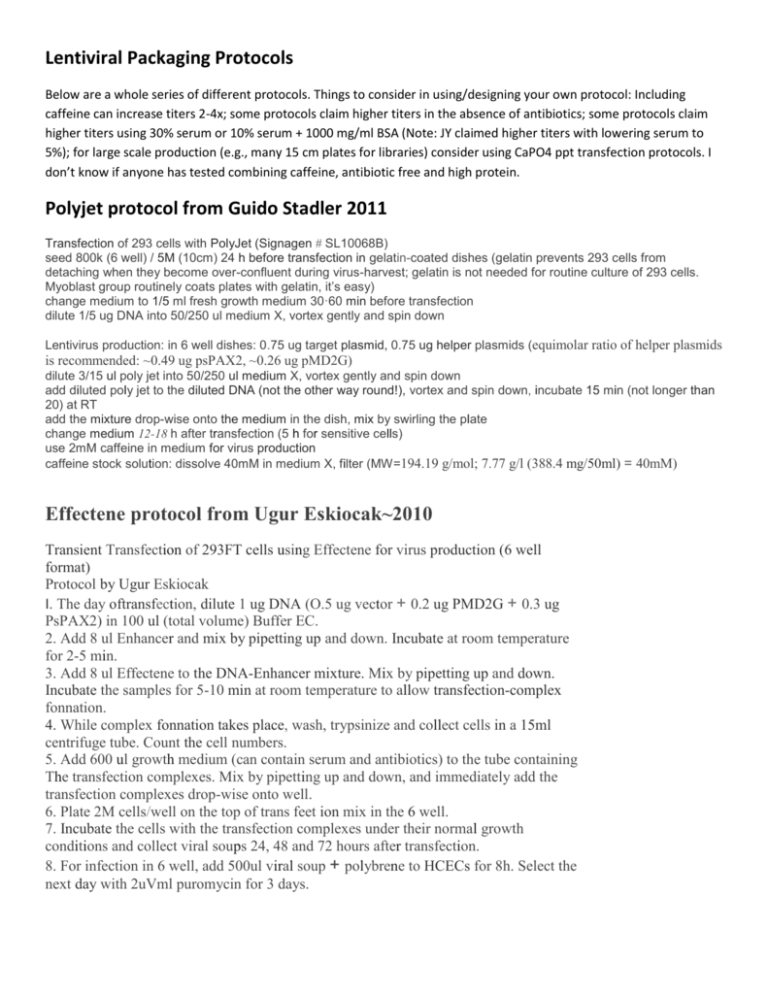
Lentiviral Packaging Protocols Below are a whole series of different protocols. Things to consider in using/designing your own protocol: Including caffeine can increase titers 2-4x; some protocols claim higher titers in the absence of antibiotics; some protocols claim higher titers using 30% serum or 10% serum + 1000 mg/ml BSA (Note: JY claimed higher titers with lowering serum to 5%); for large scale production (e.g., many 15 cm plates for libraries) consider using CaPO4 ppt transfection protocols. I don’t know if anyone has tested combining caffeine, antibiotic free and high protein. Polyjet protocol from Guido Stadler 2011 Transfection of 293 cells with PolyJet (Signagen # SL10068B) seed 800k (6 well) / 5M (10cm) 24 h before transfection in gelatin-coated dishes (gelatin prevents 293 cells from detaching when they become over-confluent during virus-harvest; gelatin is not needed for routine culture of 293 cells. Myoblast group routinely coats plates with gelatin, it’s easy) change medium to 1/5 ml fresh growth medium 30·60 min before transfection dilute 1/5 ug DNA into 50/250 ul medium X, vortex gently and spin down Lentivirus production: in 6 well dishes: 0.75 ug target plasmid, 0.75 ug helper plasmids (equimolar ratio of helper plasmids is recommended: ~0.49 ug psPAX2, ~0.26 ug pMD2G) dilute 3/15 ul poly jet into 50/250 ul medium X, vortex gently and spin down add diluted poly jet to the diluted DNA (not the other way round!), vortex and spin down, incubate 15 min (not longer than 20) at RT add the mixture drop-wise onto the medium in the dish, mix by swirling the plate change medium 12-18 h after transfection (5 h for sensitive cells) use 2mM caffeine in medium for virus production caffeine stock solution: dissolve 40mM in medium X, filter (MW=194.19 g/mol; 7.77 g/l (388.4 mg/50ml) = 40mM) Effectene protocol from Ugur Eskiocak~2010 Transient Transfection of 293FT cells using Effectene for virus production (6 well format) Protocol by Ugur Eskiocak I. The day oftransfection, dilute 1 ug DNA (O.5 ug vector + 0.2 ug PMD2G + 0.3 ug PsPAX2) in 100 ul (total volume) Buffer EC. 2. Add 8 ul Enhancer and mix by pipetting up and down. Incubate at room temperature for 2-5 min. 3. Add 8 ul Effectene to the DNA-Enhancer mixture. Mix by pipetting up and down. Incubate the samples for 5-10 min at room temperature to allow transfection-complex fonnation. 4. While complex fonnation takes place, wash, trypsinize and collect cells in a 15ml centrifuge tube. Count the cell numbers. 5. Add 600 ul growth medium (can contain serum and antibiotics) to the tube containing The transfection complexes. Mix by pipetting up and down, and immediately add the transfection complexes drop-wise onto well. 6. Plate 2M cells/well on the top of trans feet ion mix in the 6 well. 7. Incubate the cells with the transfection complexes under their normal growth conditions and collect viral soups 24, 48 and 72 hours after transfection. 8. For infection in 6 well, add 500ul viral soup + polybrene to HCECs for 8h. Select the next day with 2uVml puromycin for 3 days. Effectene protocol from Ryan Laranger for Myoblasts ~2010 MAKING "hCPK4 VIRUS" FOR TRANSDUCTION (in 293FT in MediaX 10%S) PMD26 = 285ng/ul PSPAX2 = 345ng/ul pUE3-lenti-hCDK4 = 250ng/ul l. MIX IN A TOTAL Of lug of DNA contained in 100ul of Buffer EC: 0.5 ug of~hCDK4 vector (2 ul) 0.2 ug of PMD2G (1 ul) 0.3 ug of PsPAX2 (1 ul) 2. • Add 8 ul of Enhancer and mix by pipetting up and down. • Incubate at room temp for 2-5 minutes 3.• Add 15 ul of Effectene to the DNA-Enhancer mixture. • Mix by pipetting up and down. • Incubate for 5-10 f inutes at RT 4.Wash, trypsinize and collect cells in a 15ml falcon tube. Count the cell and dilute them to l million/ml 5. Add 600 ul of growth medium to the tube containing the transfection complexes. Pipette up and down and immediately add the transfection complexes drop-wise onto wells 6.•Plate2 million cells per well on top of the transfection mix (6 well tray) 7.• !ncubate cells with the transFection complexes and collect viral sups (replace l.5ml of media; freeze down 750ul and use 750ul to transduce). / Lentiviral Production Protocol adapted from Marcu lab, obtained from JY Kim~2009 -The day before transfection: I. Plate out __ 293FT cells per 10cm plate or __ (up to 6M) cells per I5cm plate in either 10 or 25ml X media, respectively. -The day of transfection: 1. Check to make sure cells are at least 25% confluent before continuing. 2. Combine the appropriate amount of plasmid DNAs in a 15ml conical tube: For 10em plates: 5ug DNA 3-4ug psPAX2. (structural vector) 1-2ug pMDG2 (envelope vector) 10ugTOTAL For I5cm plates: I5ug DNA 7.5ug psPAX2 (structural vector) 7.5ug pMD2.G (envelope vector) 30ugTOTAL (rest of the protocol is for 15cm plates) 3. Add filtered water to a final volume of 878ul. ) 4. Add 122u12M CaCl2, (stock in -20C walk-in freezer) and mix. 5. Add 1000ul of2xHBS (stock in -20C walk-in freezer). 6. Use a 1 ml pipette tip and an automated pipettor to generate bubbles for l0s at the bottom of the tube and l0s going up and down the mixed solution. 7. Let mixture sit for 15m. 8. Remove appropriate amount of media from 293FT cells so that only 18ml is left. 9. Add all of mixture to the cells gently and evenly. Swirl to distribute evenly and put back in incubator OIN. -The day after transfection: 1. Check transfection efficiency for fluorescent marker if possible. 2. Change to the media for the cell type for which the virus is being produced. -The next day: 1. Harvest viral supematant and filter through a 0.45Um filter. (can collect viral supernatant up to 3 days after transfection) 2xHBS: 50mM HEPES 10mM KCl 12mM Dextrose 280mM NaCl 1.5mM Na2HPO4 Resuspend in 900 ml H2O, adjust pH to 7.04 (with NaOH if using HEPES free acid, with HCl if using HEPES sodium salt). Raise volume to 1000 ml and carefully re-adjust final pH to 7.05 exactly (IMPORTANT: pH needs to be very precise at pH 7.04 – 7.05). Filter through 0.22 uM and store in aliquots at -20°C (should be good for up to 6 months). The RNAi Consortium Protocol 1/18/07 Section II: Lentiviral Production Introduction: This section contains protocols for the production of lentivirus stocks from hairpin-pLKO.1 plasmids in 6 cm plates. Lentiviral production consists of the following steps: Day 0 Seed 293T packaging cells Day 1 (pm) Transfect packaging cells with 3 lentivirus plasmids (hairpin-pLKO.1 vector, packaging plasmid, envelope plasmid) Day 2 (am) 18 hours post-transfection: Remove media; replace with fresh high-BSA or high-serum media Day 3 (am) 24 hours after media change: Harvest virus; replace with fresh high-BSA or high-serum media Day 4 (am) 24 hours after harvest 1: Harvest virus; discard packaging cells These procedures should be carried out in accordance with biosafety requirements of the host institution Part 1: Lentiviral Production in 6 cm plates I. Materials Transfection-quality plasmid DNA for: - hairpin-pLKO.1 vector (TRC library plasmid – see Section I) - 2nd generation packaging plasmid containing gag, pol and rev genes (e.g. pCMV-dR8.91 or pCMVdR8.74psPAX2)* - envelope plasmid (e.g. VSV-G expressing plasmid, pMD2.G)* * recommended: use endotoxin-free plasmid isolation kits (Qiagen) TransIT-LT1 transfection reagent (Mirus Bio, MIR 2300/5/6) alternative: FuGENE 6 (Roche, #1 814 443 or #1 988 387) OPTI-MEM serum-free media (Invitrogen, #31985-070) 293T packaging cells (recommended: passage number < 10) Cell seeding media: Low-antibiotic 293T growth media (DMEM + 10% iFBS + 0.1x Pen/Strep) 500 mL DMEM (Dulbecco's Modification of Eagle's Medium; e.g. Mediatech #10-013-CV) 50 mL iFBS (heat-inactivated Fetal Bovine Serum; e.g. HyClone #SH30071.03) 0.5 mL 100x Pen/Strep (10,000 IU/mL penicillin, 10,000 μg/mL streptomycin; e.g. Mediatech #30-002-CI) Viral harvest media: High-BSA 293T growth media (DMEM + 10% iFBS + 1.1g/100mL BSA + 1x Pen/Strep) 500 mL DMEM (Dulbecco's Modification of Eagle's Medium; e.g. Mediatech #10-013-CV) 50 mL iFBS (heat-inactivated Fetal Bovine Serum; e.g. HyClone # SH30071.03) 32 mL 20g/100mL BSA stock (microbiology-grade Bovine Serum Albumin; VWR #14230-738) 5 mL 100x Pen/Strep (10,000 IU/mL penicillin, 10,000 μg/mL streptomycin; e.g. Mediatech #30-002-CI) alternative viral harvest media: High-serum 293T growth media (DMEM + 30% iFBS + 1x Pen/Strep) 500 mL DMEM (Dulbecco's Modification of Eagle's Medium; e.g. Mediatech #10-013-CV) 200 mL iFBS (heat-inactivated Fetal Bovine Serum; e.g. HyClone # SH30071.03) 5 mL 100x Pen/Strep (10,000 IU/mL penicillin, 10,000 μg/mL streptomycin; e.g. Mediatech #30-002-CI) 6 cm tissue culture plates Polypropylene storage tubes II. Instructions 1. Seed 293T packaging cells at 1.3-1.5x105 cells/mL (6 mL per plate) in low-antibiotic growth media (DMEM + 10% iFBS + 0.1x Pen/Strep) in 6 cm tissue culture plates. 2. Incubate cells for 24 hours (37 °C, 5% CO2), or until the following afternoon. After ~24 hours, the cells should be ~70% confluent. 3. Transfect packaging cells: a. Prepare a mixture of the 3 transfection plasmids: Reagent per 6 cm plate packaging plasmid (e.g. pCMV-dR8.91 or pCMV-R8.74psPAX2) 900 ng envelope plasmid (e.g. VSV-G/pMD2.G) 100 ng hairpin-pLKO.1 vector 1 μg OPTI-MEM to total volume 10 to 30 μL* * The volume of OPTI-MEM per well can be adjusted for optimal handling. b. Dilute TransIT-LT1 transfection reagent in OPTI-MEM. Add the TransIT-LT1 reagent dropwise and mix by swirling the tip or gently flicking the tube (do not mix by pipetting or vortexing). Incubate 5 minutes at room temperature. Reagent per 6 cm plate TransIT-LT1 6 μL OPTI-MEM to total volume 90 μL c. Add the 3 plasmid mix dropwise to the diluted TransIT-LT1 reagent and mix by swirling the tip or gently flicking the tube. d. Incubate the transfection mix for 20 - 30 minutes at room temperature. e. Carefully transfer the transfection mix to the packaging cells (in low-antibiotic growth media). The packaging cells can be sensitive to perturbation - take care not to dislodge the cells from the plate. The total volume of transfection mix should be 100 to 125 μL per plate. 4. Incubate cells for 18 hours (37 °C, 5% CO2), or until the following morning. 5. Change media to remove the transfection reagent and replace with 6 mL high-BSA growth media or high serum growth media for viral harvests. 6. Incubate cells for 24 hours (37 °C, 5% CO2). 7. Harvest media containing lentivirus at ~40 hours post-transfection. Transfer media to a polypropylene storage tube. Replace with 6 mL high-BSA growth media or high serum growth media for viral harvests. 8. Repeat viral harvesting every 12-24 hours and replace with 6 mL high-BSA growth media or high serum growth media for viral harvests. Viral titer tends to decrease in later harvests; we typically collect a total of 2-3 time points. After the final harvest, discard the packaging cells. The viral harvests may be pooled as desired. 9. Spin the media containing virus at 1250 rpm for 5 minutes to pellet any packaging cells that were collected during harvesting. Transfer the supernatant to a sterile polypropylene storage tube. 10. Virus may be stored at 4 °C for short periods (hours to days), but should be frozen at -20 °C or -80 °C for long-term storage. To reduce the number of freeze/thaw cycles, aliquot large-scale virus preps to smaller storage tubes prior to long-term storage.
